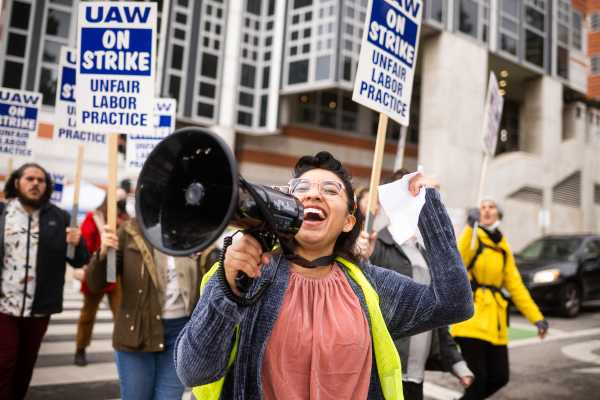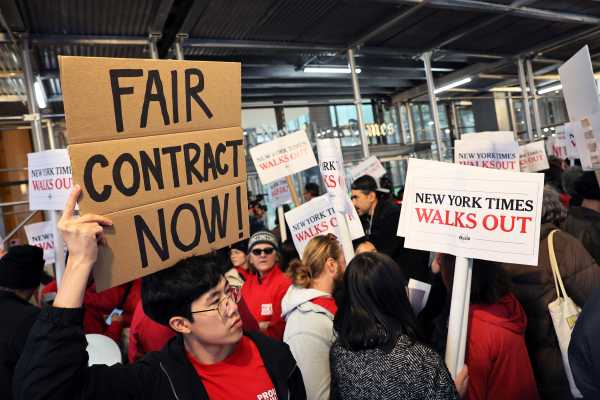
Rani Molla is a senior correspondent at Vox and has been focusing her reporting on the future of work. She has covered business and technology for more than a decade — often in charts — including at Bloomberg and the Wall Street Journal.
This story is part of a group of stories called

Uncovering and explaining how our digital world is changing — and changing us.
Marissa Peterson quit her job as a bartender in Durham, North Carolina, in June, after she was sexually assaulted by a customer and felt management didn’t do enough to keep her assailant from returning to the establishment.
Her decision, Peterson said, was informed by time she spent at home during the pandemic, after being laid off from another job. Extended pandemic unemployment insurance gave her, for the first time in her adult life, space from work and time to consider her relationship with it.
“I was able to truly start thinking about how I had been mistreated by several employers, and just the things that I tolerated, and, unfortunately, how I allowed them to mistreat me by not saying anything or by not leaving sooner,” she said.
When the incident happened at her new job, the decision was clear, even though it meant missing out on much-needed paychecks.
“When I ended up quitting, it was because I felt as though my own self-respect was worth more than money,” Peterson explained.
Even as the worst of the pandemic has waned and many things have returned to normal, many are refusing to let work return to how it was before. Workers like Peterson are expressing that sentiment by their willingness to quit their jobs. Currently, the quit rate in the US is at 2.6 percent, down from its peak of 3 percent last winter but still above historic norms. In other words, the Great Resignation is still going. Others are trying to improve the jobs they’re in through collective action like unionizing and striking. Those who were able to work from home during the pandemic and felt it made their jobs and lives better are refusing to come back to the office.
These decisions have been made possible, in part, by a tight hiring market where employers have struggled to find enough workers. But the fact this scenario has lasted so long — as extended unemployment insurance ran out, as layoffs crowd the headlines — suggests there’s more at play. There seems to have been a fundamental shift in how many Americans consider work’s role in their lives, moving the needle ever so slightly from “live to work” to “work to live.”
This change came about for many reasons. The pandemic shed more light on and caused more appreciation for the plight of front-line workers, whose jobs were exceedingly difficult and underpaid even before they became more overtly dangerous. For knowledge workers, who can do most tasks with just a computer and an internet connection, it showed that commuting to a physical location wasn’t necessary to do their jobs or for their companies to thrive. Perhaps most poignantly, the millions of deaths that the pandemic wrought showcased the fleetingness of life and made people a little more cautious about how they spend their short time on Earth.
Importantly for many Americans — including Petersen, who currently works three jobs —quitting is not simply a decision of having an income or not. Many Americans have learned how to survive on a spouse’s income, dwindling savings, or simply less. That means the decision to quit a job is a little less arduous than it used to be.
In some ways, the current moment is also a reaction to what came before, when overwork became not only commonplace but also glorified, according to Simone Stolzoff, author of the upcoming book The Good Enough Job. The 2000s and 2010s were plagued by celebrity tech CEOs, hustle culture, and the misplaced promise of the #girlboss.
“Now we’re seeing the pushback,” Stolzoff said. “Employees have been able to see an alternative both with their eyes on social media and taste it in their lived experience of their own work.”
As we enter a potential recession — even a jobful recession, as some have dubbed this one — jobs will likely become scarcer, and decisions to leave or fight back at work will become tougher. Still, there are reasons to believe this era of worker power won’t go away without a fight.
Demographic changes in the US, including an aging population, low birth rates, and low immigration, suggest the tight hiring market could continue beyond the pandemic. And as members of Generation Z, some of whom came of age during the pandemic and its hardships, enter the job market, so too will their views on work, which are decidedly critical.
How long this era of worker power lasts could change what more workers expect from their jobs. And depending on how aggressive workers get with their demands, employers could change what they have to offer in the first place.
The fight to keep work remote
What worker power looks like in practice varies by industry and by worker, but it has cropped up most noticeably among knowledge workers as a push to continue working from home. People are eating at restaurants and attending concerts and sporting events, but they have not returned to the office at pre-pandemic rates, suggesting their reluctance is not simply due to fears of getting Covid. After successfully working from home for more than two years while corporations made record profits, many companies’ decisions to call workers back to the office have fallen on deaf ears. That has meant many workers have refused to come back in, while others have gone as far as to quit in order to find the privilege at another employer.
The jobs with the biggest growth in people looking to quit are in positions that were remote during the pandemic and where people are being called back, according to a new report from compensation software company Payscale.
Craig Register, a father of two in Los Angeles, quit his job directing operations at a beauty company in January after his employer asked workers to return to the office full time. Register said he left along with his whole team, but soon got a call from the company attorney asking if he’d come back, remotely, until the company found a replacement. He did, and it took two months.
For Register, who spoke to Recode after he was able to duck out of work midday to see his son’s play, there was no going back to his hour-long commute each way and trying to juggle child care.
“You went to work and you commuted if you had to, and that was just the way things were,” Register said. “Then the pandemic really, I think, opened a lot of people’s eyes to, well, it can be a different way, and this different way is better.”
Remote work has had even more dramatic impacts on people’s lives, like allowing people to become homeowners since they weren’t tied to a single region and its real estate costs.
“Then the pandemic really, I think, opened a lot of people’s eyes to, well, it can be a different way, and this different way is better”
Dustin Tanner, an interface designer at Apple, had been commuting three hours back and forth to company headquarters in Cupertino, California, each day. When the pandemic hit and Tanner was able to work remotely, he was finally able to afford a home he and his family had long wanted — in Texas.
“The housing market is so crazy that even working in the executive design team at Apple designing flagship products, it was still really hard to buy a home if you hadn’t been established in California for a long time,” he said.
When Apple told workers this past summer they’d be expected to return to the office three days a week, Tanner considered flying back and forth from Texas every week but ultimately decided to give up his “dream job” in exchange for one that would allow him to continue working remotely and spend more time with his family.
“If we take those remote opportunities, we don’t have to make all these sacrifices,” he said.
Remote jobs make up less than 15 percent of jobs on LinkedIn but get more than half of all applications, the company told Recode. That suggests there are more people who want to work remotely than there are jobs. It also suggests that employers who offer remote work will get more interest.
It’s also possible that workers won’t have to fight as hard for remote work soon, as the move to return to the office is coming up against the need to save money. Employers, loath to fire workers, are cutting back on office space instead.
Currently, 79 percent of people whose jobs could be done from home are working from home, either in a hybrid or fully remote arrangement, according to data from Gallup. That rate has remained surprisingly consistent over the last year and a half.
The state of the union is strong
Workers are not only taking stands on single issues like remote work, they’re collectively organizing to tackle a much broader range of issues. Americans are joining unions at levels not seen in years, as workers organize to get better conditions. More than 1,000 unions have won elections in 2022, the most since 2015, according to preliminary data for this year provided by Bloomberg Law, which will likely be revised upward. People are also organizing in sectors that were once considered impossible to unionize, like retail. Workers at Starbucks, Apple, Amazon, and Trader Joe’s all unionized this year in the hope of getting better working conditions by collectively organizing.
The pandemic, again, seems to be the galvanizing force here, Kate Bronfenbrenner, director of labor education research at Cornell University’s School of Industrial and Labor Relations, told Recode.
“They were greedy, and they took too much from workers, expected too much from workers, and, most of all, took too much for themselves,” she said, referring to companies and their record profits while workers, especially front-line workers, endured poor working conditions. “I think that’s the spark.”
It helps that there’s extremely high approval for unions in the US right now, with more people saying they support unions than at any time since 1965. That’s happening even in the face of strikes that could potentially make life more difficult for Americans.
“They took too much from workers, expected too much from workers, and, most of all, took too much for themselves”
There were 360 strikes from January to November this year, a 45 percent jump from the same period last year — which was also a big year for strikes — according to data shared by Johnnie Kallas, project director of Cornell’s ILR Labor Action Tracker. Earlier this year, 15,000 nurses went on strike in Minnesota to try and get better staffing and patient care. Last month, Starbucks workers across the country stood on picket lines on what’s considered one of the company’s busiest days of the year in the hope of getting the company to finally bargain on a contract. Congress was forced to intervene earlier this month to stop a rail strike, as rail workers nearly incapacitated cross-country trade to protest strict attendance policies and the fact that they don’t have a single paid sick day. And last week, more than 1,000 New York Times employees stepped off the job and asked readers not to cross their digital picket line by going to any of the company’s publications to protest stalled contract negotiations.
The more people unionize and strike, the more others are encouraged to do so as well.
“Organizing and strikes are contagious,” Bronfenbrenner said. “When they see that workers just like them have done it and succeeded, it inspires them that they can do it, too.”

That was the case for Tracy V. Wilson, host of the podcast Stuff You Missed in History Class, who successfully organized with her colleagues at iHeartMedia, which voluntarily recognized the union in February.
“Seeing other podcast shops successfully unionize and successfully bargain contracts was a pretty big inspiration,” Wilson said. “A lot of the same core issues drove my colleagues to start organizing.” Those issues include overwork and not having enough resources to do their jobs.
Writ large, these realizations have caused workers across the country and across industries to try their hand at unionizing and to test just how much power they have.
The case for continuing worker power
The current situation won’t last forever. Layoffs and fewer job openings will put a dent in worker power. And the magnitude and length of any coming recession will determine just how big that hit will be. Still, there are structural and cultural reasons to think worker power has staying power.
While the working-age population is still growing, it’s not growing as fast as it has historically, according to a recent report by market analytics firm Lightcast, formerly Emsi Burning Glass. And as boomers age, more people will be retiring and leaving the workforce than entering it. By 2034, older Americans will outnumber children for the first time in history, according to census projections.
Compounding the situation are low immigration numbers and low workforce participation rates. The labor force participation rate, or the share of the working population that’s working or wants to work, is still notably lower than it was pre-pandemic, thanks to fears of the ongoing pandemic, early retirement, and terrible child care options, among other reasons.
All of this goes to say that there aren’t enough workers, so those who are working have a little bit more power and not as much fear of replacement as they would otherwise. Additionally, the generation entering the workforce may not be as deferential to their employers as their predecessors.
Gen Z workers have a front-row seat to an economy where wage growth isn’t enough to counter inflation and where no matter how hard they work, they may never be able to afford a home like their parents or grandparents. That’s done a number on their career outlook. People in Gen Z, the oldest of whom are about 25, say they’re forgoing striving and ambition in exchange for leisure and simply enjoying life. They’re working out of financial necessity rather than some inborn calling. And they expect a lot more out of their jobs than previous generations.
That’s not to say getting better working conditions will be easy. Forming a union and negotiating a contract is an uphill battle with odds in favor of employers. Quitting a job can be terrifying and financially ruinous. Demanding better work-life balance takes a lot of energy. Still, many workers have done the calculus and have decided that better work is worth it.
“If workers aren’t feeling safe or fairly compensated or protected, they will continue to speak up and advocate for change,” Stoltzoff said. “I imagine there will be fewer workers quitting with nothing lined up on the other side, but I think the push to try and reform and make the workplace better will continue.”
Sourse: vox.com





